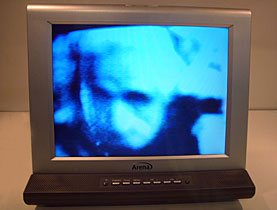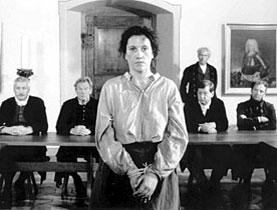Paranormal exhibition offers tricks and treats

The voice is barely audible but a careful listener can just make out, "Can you hear me?"
The recording is one of many personal tales of paranormal contact featured at the Museum for Communication in the Swiss capital Bern.
The exhibition, Goodbye and Hello: Dialogue with the Beyond, is unique, says curator Kurt Stadelmann.
“I think it is the first time in Europe that you can see an exhibition with these kinds of objects and phenomena,” he told swissinfo.
“At first it was very difficult to find people [to take part]. They didn’t want to talk about their experience because communication with the beyond is taboo. The hereafter is not proven and communication with the beyond is not proven. Nobody wants to say it is real.”
Despite the prospect of trying to exhibit the intangible, the museum decided it would put on an exhibition like any other.
The collection traces what claim to be connections with the dead since the 1800s in Switzerland and elsewhere.
Modern trends of turning a loved one’s ashes into a diamond are juxtaposed alongside the 19th-century practice of using hair from the dead to make decorations.
Research by Swiss author Albert Hein, one of the first to study near-death experiences after 1870, is offered alongside a recent video testimony by Magdalene Bless.
Bless was in a car crash and described being “immersed in a magnificent light” before her life flashed before her in a “fast, colourful retrospective, with all the feelings, smells and noises”.
Hidden talent?
Perhaps most intriguing are people’s attempts to record their interaction with the dead.
Over three years in the 1980s Manfred Boden’s phone conversations in Germany were interrupted by odd voices that only he could hear and which would respond to his questions. He collected three tapes of phone calls. Various engineers would tell him that there was nothing wrong with his telephone.
Boden also found that his computer recordings of biorhythms for October 21, 1980 were peppered with comments including the ominous, “I am here you die Manfred accident 16.8.1982”.
The day in question passed without incident, but Boden later said: “Before paranormal phenomena appeared to me, I would have mocked whoever told me these kinds of stories. But after what happened, I quickly lost the desire to laugh.”
Others recorded voices around them. Catholic priest Leo Schmid and engineer Viktor Bättig recorded the sounds on tapes and published books on their experiences. One voice told Schmid: “This is Van Gogh.” Bättig picked up: “Bättig, can you hear me?”
Some people claim to develop unusual artistic talents. Heinrich Nüsslein from Nuremberg could complete an intricate painting in 30-minute trances and produced around 30,000 works of art as a self-styled “metaphysical painter”.
In the 1960s Rosemary Brown, a widow from London, claimed the world’s greatest classical composers would dictate works to her. She transcribed hundreds of compositions and later released an album.
Fraudsters
The exhibition’s star attraction tells of a chess game played out between 1985 and 1993 between the oldest active grandmaster on the circuit, Viktor Korchnoi, and one-time Hungarian grandmaster Géza Maróczy – who died in 1951.
Medium Robert Rollans, an inexperienced player, was brought in for the game, which was won by Korchnoi in 47 moves. The findings were published in the Journal of the Society for Psychical Research in 2002.
Another highlight is a bread knife that belonged to the renowned Swiss psychiatrist Carl Gustav Jung, and which he documented as suddenly exploding into four pieces in 1898. Loaned from a personal collector, it is on show for the first time in Bern.
A final dose of scepticism is offered at the end, showing some of the more well known fraudsters and a scientist firmly arguing against the existence of any such paranormal goings-on.
“Everybody has an opinion about the beyond. We tried to show two extreme positions for the visitor. It is the visitor who has to decide what is right or wrong for him,” Stadelmann explained.
Some visitors are speaking up. According to a visitor questionnaire, women leave far more convinced than men that there is an afterlife and that ghosts exist.
“We live in a very logical world. For me personally I had the experience [during this exhibition] that there are a lot of things in this world which cannot be explained,” Stadelmann added.
swissinfo, Jessica Dacey
The collection at the Museum for Communication can be divided into three sections: communication from the living towards the dead (such as seances), the dead towards the living (apparitions), and dialogue back and forth (via so-called mediums).
It looks at western society’s views of the deceased and recounts experiences from “the other side” by near-death exponents.
Experts give their view of a supposedly haunted house and in videos of seances mediums summon spirits in hushed voices. Spooky sounds are picked up on telephone lines and in rooms, while on a television screen the image of Albert Einstein strangely appears.
Mediums and scientists share their opposing perspectives of the existence of an afterlife and obvious fakes are named and shamed.
The exhibition at the Museum for Communication in Bern runs until July 2009.

In compliance with the JTI standards
More: SWI swissinfo.ch certified by the Journalism Trust Initiative












You can find an overview of ongoing debates with our journalists here . Please join us!
If you want to start a conversation about a topic raised in this article or want to report factual errors, email us at english@swissinfo.ch.